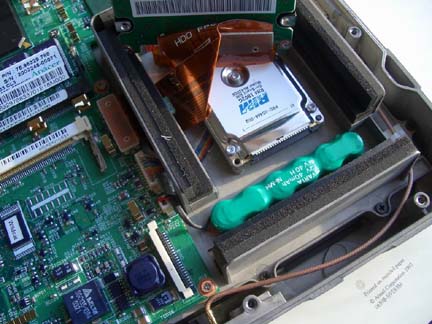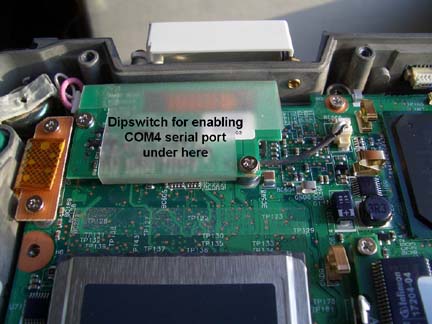
RIM 1902g Modem
I was unable to get the RIM 1802g GPRS modem working. However I have left this writeup here, for those who would like to have a go. I am pretty sure I needed an extra piece of information, but without a contact inside Xplore this never came. It would have been a great solution for GSM, GPRS and FAX.
The following documents appeared on the RIM website:
Integrator Guide
AT Commands Guide
Getting Started Guide
Release Notes 1
2
3
4
I obtained the RIM 1802g modem from the UK distributor Alpha Micro who have a stock of them left over.
Configuring the RIM 1802g GPRS modem
A good question was how the ix104 implements WAN access using the RIM modem, so as to create a network connection within Windows. I have previously used a Sierra 750 GPRS card to get internet access on a laptop. This came with a Vodafone PAYG (prepaid) SIM card and the Vodafone software, though pretty rough, did everything. Just click on a Connect button and after a few seconds Windows would pop up saying it has a network connection!!
The RIM 1802g module is basically a Hayes-compatible modem, with additional AT commands to enable the extra features. As is common with GPRS, the ix104 uses Windows Dial-Up Networking to implement internet access.
The RIM modem fits under the ix104 hard disk. The hard disk itself isn't screwed down; it is held in place laterally by foam and vertically by the two halves of the ix104 casing. You just lift it out - carefully to not damage the flat cable which connects it to the ix104 motherboard. The RIM modem lays underneath it, located by two pegs and secured by two M2 screws (screws not present in pic below)

I had one RF cable which was way too long for the Cisco wifi card, so it was used for the RIM modem antenna connection, with the surplus length folded away as shown in the pic below.

Before installing the modem, you need to place the SIM card into it. But beware, because once inside the ix104, the SIM card will be inaccessible. This can raise top-up issues.
The RIM modem needs a flat 22-way connecting cable, about 5" long, with contacts that appear on the same side of it:
(pic)
It can be obtained from the modem supplier.
When I initially fitted the RIM modem, Windows XP would not detect it because it (XP) did not show any COM ports! This modem is an RS232 device so clearly needs a serial port in the PC. The ix104 BIOS does not have any config for enabling serial ports. However, I found some info on the web which shows that one must move a switch on the motherboard, located under what they call an "inverter":

Upon setting the switch and reassembling the ix104, Windows reports it has found a "USB high speed serial converter" so evidently the ix104 uses a motherboard-located USB-RS232 converter to create the RS232 port for the RIM modem. Windows then asks whether it should look for a driver for it (which includes going to the Microsoft website); I answered Yes and after about 30 seconds it found a driver from somewhere and installed it. I happen to know there are only about two companies who make USB-serial converter chips (Prolific of Taiwan, FTDI in the UK) and have used both of these in designs; the driver installed by the ix104 is the FTDI one.
Windows then asks if you want to install a driver for a "USB serial port". I don't know why this happens given that one has already done it above. It prompts for a confirmation to install software not certified by Microsoft; answer Yes. More FTDI drivers get installed and everything looks good. Now, in Control Panel > System > Device Manager one can see, for the first time, an entry under Ports (COM and LPT) and entry showing one serial port which is COM4. This suggests that COM1,2,3 do exist already but don't ask me where they are!!!
Referring to the ix104 modem config documents (above), one can enable a 33600 baud modem on COM4. However the modem could not be interrogated - as if it wasn't connected. After some investigation, I found that the pin connections shown on page 18 of the above document "Installing OEM Radio Card", which show pin 22 near the ix104 edge, are no doubt right for the connector itself but are in fact in the reverse order for the RIM modem!! The flat cable is meant to interconnect the two connectors as follows: pin 1 to pin 22, pin 2 to pin 21, etc. A cable which has the bare contacts on the same side does this job. I very carefully checked that the ground connections to the modem were correct (by reference to the modem data sheet) with the cable I used.
However I was unable to get the RIM modem working. COM4 comes up fine but the modem query function under Modem Properties fails to return anything. Maybe one needs some extra software to get this modem to "wake up". I checked that it had power (4.0V) on it; I didn't check that the ix104 serial port (clearly the right one for the modem) was doing anything.
I suspect that I needed an extra piece of info or an extra piece of software. Recently I received a suggestion from someone that the problem might be due to the RTS signal to the modem being in the LOW state, and that the "radio-on" utility mentioned in one of Xplore's notes turns this on. Due to the time I had already spent on this, and due to the difficulty of doing any mods and repeatedly opening/closing the case with its many screws, I did not test this. The bottom line is that one can buy a Vodafone- or some other network provider-badged GSM/GPRS PCMCIA card like the Sierra 750 for a lot less than the RIM modem, and it comes with a SIM card and all required software which avoids messing about with initialisation strings...
Page last edited 29th April 2005